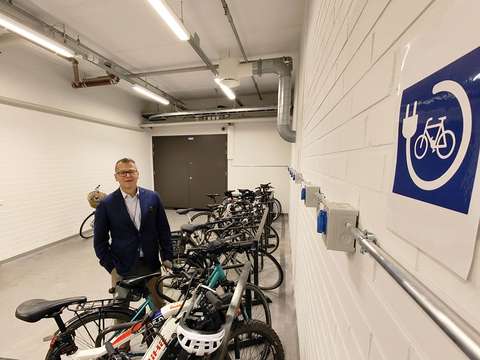Full-service office building reduces mobility needs

LähiTapiola’s head office in Tapiola makes it easy to give up the car.
The bicycle park at LähiTapiola’s head office has a long row of bikes ranging from trendy city bikes to high-end electric mountain bikes. At the workplace of over 1,000 people, bicycle commuting does clearly not end with the arrival of autumn. Adverse weather conditions are no problem when there is a separate parking facility with charging places for the bikes and a personal locker in the locker room for your office clothes. At the end of the bike trip, you can visit the morning sauna and have breakfast in the café upstairs, for example.
“Getting around by other means than a car must be made easy,” says Jari Collan, HR Service Director at LähiTapiola.
Traffic accounts for one-third of all greenhouse gas emissions in Espoo. LähiTapiola has already taken significant environmental action when deciding the location of its head office.
“You can get here by metro. Getting around with a scooter, bike or on foot is easy,” explains Jari Collan.
It is only a 10-minute walk from Revontulentie to Tapiola metro station.
Large employers’ decisions have a decisive impact on the entire region’s mobility needs and transport emissions. Espoo aims to be a carbon-neutral city by 2030, while LähiTapiola plans to be carbon-neutral in its operations already in 2025. The company’s sustainability report reveals that the carbon footprint is measured fairly comprehensively. The annual carbon footprint calculations consider, for example, emissions from telecommuting, such as the energy consumption of the workers’ laptops.
Traffic accounts for one-third of Espoo’s greenhouse gas emissions. Commuting takes place every weekday, so the emissions are significant. Workplaces help to drive sustainable mobility as outlined in the Sustainable Espoo programme. This series of stories tells about actions by Espoo employers to cut emissions from commuting. Read the other stories in the series → Company bike to the office to get the most out of commuting, City bikes close the distance between metro stations and workplace ja Pastor rides a bicycle to work.
Telecommuting has reduced traffic emissions
LähiTapiola’s largest source of emissions is indirect emissions, which include not only the commuting of personnel but also greenhouse gas emissions reported by LocalTapiola’s construction projects and investments.
“Our business includes insurance, construction and investment operations. Emissions from commuting are relatively low for the operations as a whole. But they still require attention,” says Sustainability Specialist Suvi Järvinen.
The most dramatic impact on LähiTapiola’s personnel commuting has been the increase in telecommuting. At the beginning of the corona epidemic, car traffic decreased by as much as 40 per cent in Espoo. Still, traffic volumes have now returned almost to the level before the pandemic. By contrast, the change seems permanent in expert companies such as LähiTapiola, where many work part of the week from home.
“Our telecommuting policy is two days a week at the office, the rest remotely,” Collan says.
The sustainability report calculations also prove that the increase in telecommuting has reduced emissions from commuting. Emissions from LähiTapiola business trips in 2021 were only one-half of the level before the pandemic, and personnel’s commuter traffic has fallen by nearly a quarter.
A few steps to lunch and the gym
Reducing car traffic has proven to be a major challenge for the rapidly-growing Espoo. Even the rapid increase of electric cars cannot bring Espoo traffic emissions down quickly. For its part, LähiTapiola aims to promote the popularity of modes of transport that are more sustainable than passenger cars.
“We don’t encourage driving,” Collan says.
For example, the use of a company-car benefit as an employee benefit has been replaced by the Epassi service, which can be used to pay for lunches, concert tickets or commuting with public transport. The employer uploads €200 a year to the service. The money can be used to buy a monthly public transport ticket, for example.
Emissions from mobility are also reduced by the hotel-level services provided in the head office. Cafés offer snacks, and there is no need to go look for a lunch place in the city. The aim is to eliminate the need to leave the building during an office day.
“And you don’t have to drive to a fitness centre on the way home,” Suvi Järvinen says.
There is a gym with group exercise classes and massage services on the premises.
TEXT AND PHOTO: Petja Partanen
This article is a part of the Sustainable mobility at workplaces series of stories.